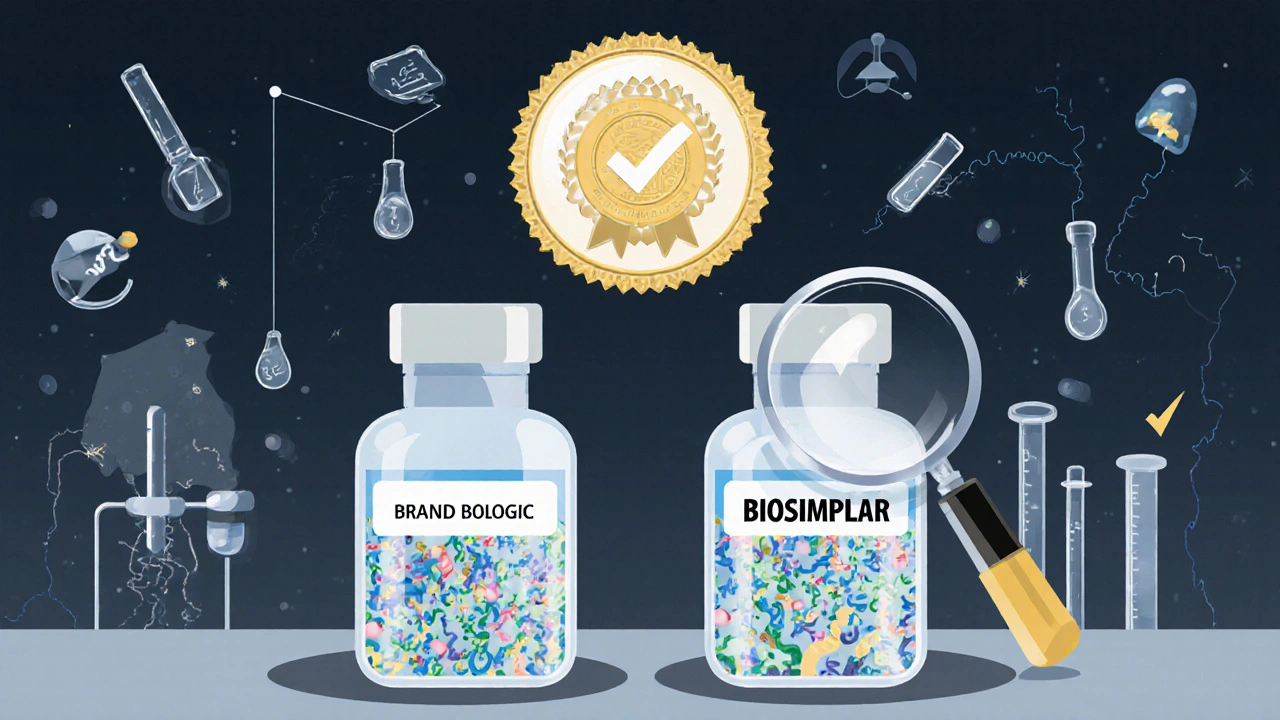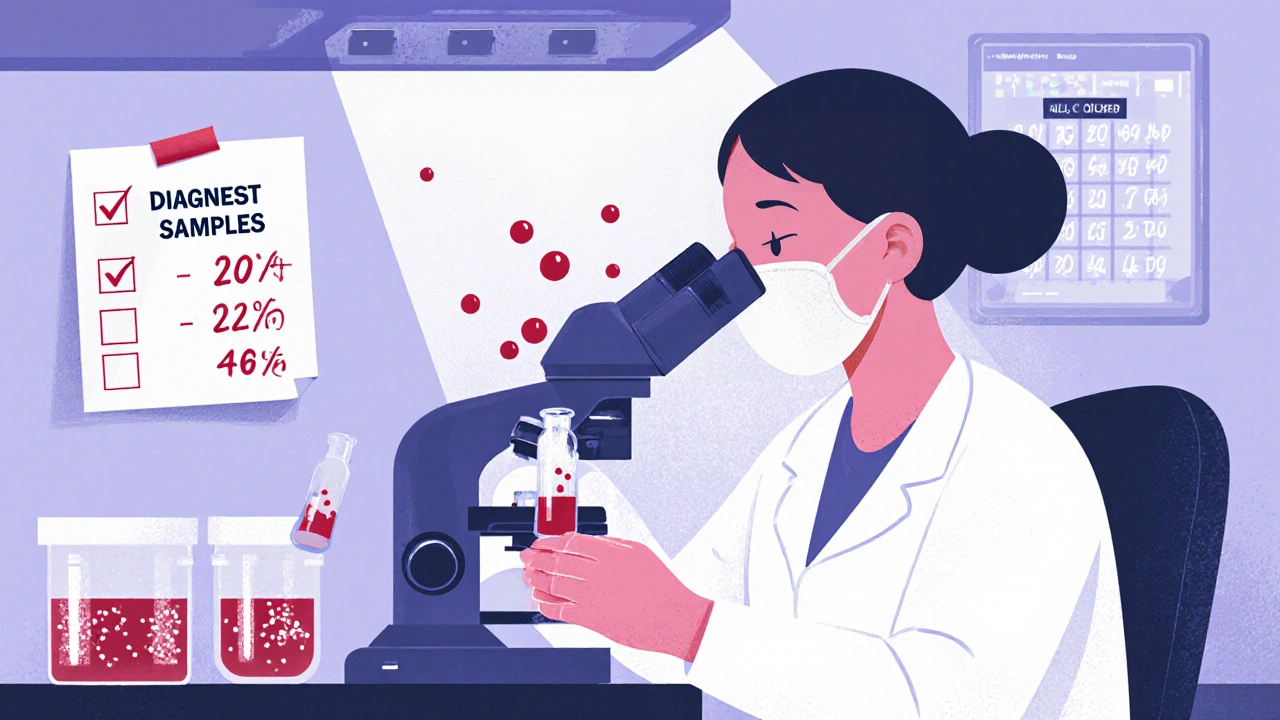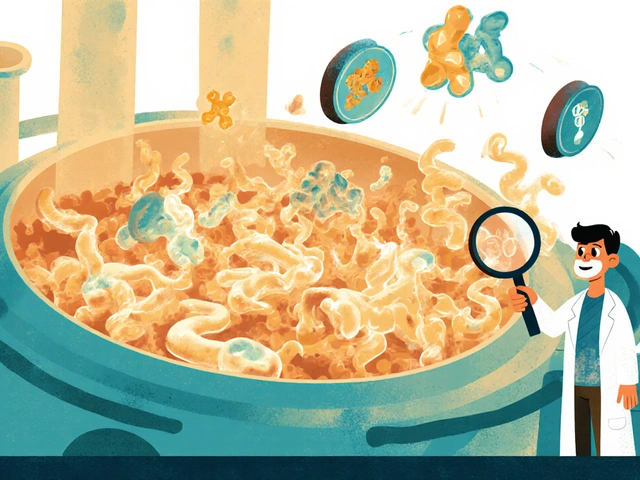When you take a pill for high blood pressure, you expect every tablet to be exactly the same. That’s because small-molecule drugs are made in a lab using chemical reactions - the same ingredients, same process, same result. But if you’re on a biologic drug - like a treatment for rheumatoid arthritis, Crohn’s disease, or certain cancers - what’s in your vial isn’t a single, identical molecule. It’s a mix of millions of slightly different versions of the same protein. And that’s normal.
Why biologics aren’t like generics
Biologics are made from living cells - yeast, bacteria, or mammalian cells grown in giant bioreactors. These cells don’t follow a blueprint like a machine. They adapt, respond to their environment, and produce proteins with tiny differences. One batch might have slightly more sugar molecules attached to the protein. Another might have a different fold in one part of the structure. These aren’t mistakes. They’re lot-to-lot variability - natural, expected, and unavoidable.This is why biosimilars can’t be called generics. Generics are exact copies of small-molecule drugs. Biosimilars are highly similar, but not identical, to the original biologic. The FDA makes this clear: "Biosimilars Are Not Generics." You can’t just swap one for the other like you would with generic ibuprofen. The differences are too subtle to measure with a simple chemical test. They require advanced tools - mass spectrometers, chromatography systems, cell-based assays - to even see.
What kind of variation matters?
The most common changes happen during something called post-translational modification. That’s a fancy way of saying: after the cell makes the protein, it adds or tweaks parts of it. Glycosylation - the addition of sugar chains - is the biggest one. These sugar patterns affect how the drug behaves in your body: how long it lasts, how strongly it binds to its target, even how your immune system reacts to it.Other changes include:
- Deamidation (loss of nitrogen from amino acids)
- Oxidation (damage from oxygen exposure)
- Fragmentation (the protein breaks apart in small ways)
- Different folding patterns
Each lot of a biologic - whether it’s the original brand or a biosimilar - contains millions of these tiny variants. The key isn’t eliminating them. It’s controlling them. The FDA requires manufacturers to show that the range of variation in their biosimilar is within the same range as the original product. Not identical. Within the same ballpark.
How regulators make sure it’s safe
The approval process for biosimilars isn’t just about proving they’re "close enough." It’s about proving they’re therapeutically equivalent despite the differences. That means three layers of evidence:- Analytical studies: Scientists compare the structure, purity, and molecular characteristics of the biosimilar and reference product using over 50 different tests. This is the foundation.
- Functional studies: Does the drug bind to its target? Does it trigger the same immune response? Does it kill cancer cells the same way? Lab tests answer these questions.
- Clinical studies: Sometimes, a small study in patients is needed to confirm that the biosimilar works the same way in real people.
For a biosimilar to be labeled "interchangeable" - meaning a pharmacist can swap it for the brand without asking the doctor - there’s an extra hurdle. The manufacturer must prove that switching back and forth between the two doesn’t increase risk or reduce effectiveness. That means running studies where patients alternate between the two products over months. Only 12 out of 53 approved biosimilars in the U.S. have this designation as of May 2024.

What this means for labs and testing
This isn’t just a drug manufacturing issue. It hits diagnostic labs too. Many lab tests use biologic reagents - antibodies, enzymes, proteins - to detect things like HbA1c (for diabetes) or troponin (for heart attacks). When a lab switches to a new lot of a reagent, they have to check: does this change the results?A 2022 survey found that 78% of lab directors consider lot-to-lot variation a "significant challenge." Why? Because quality control samples don’t always behave the same way as real patient samples. You might run perfect controls with the new lot, but when you test actual patient blood, the numbers shift by 0.5% or more. That might not sound like much - but in diabetes care, that could mean changing a treatment plan unnecessarily.
That’s why labs use statistical methods to verify new lots. They test at least 20 patient samples in duplicate and compare the results to the old lot. If the difference is within a pre-set tolerance - based on the test’s analytical performance - they approve the new lot. It’s time-consuming. In smaller labs, this can take up 15-20% of a technician’s time each quarter.
Why we can’t just eliminate variability
Some people wonder: why not just make biologics perfectly consistent? The answer is simple: we can’t. The complexity of these molecules is beyond current technology. A monoclonal antibody can have over 1,000 possible variations just from glycosylation alone. Trying to force every molecule to be identical would require a manufacturing process that doesn’t exist - and would likely be prohibitively expensive.Instead, the industry focuses on consistency within a safe range. The FDA calls this "acceptable within-product variation." Experts like Dr. Sarah Y. Chan from the FDA’s Office of Therapeutic Biologics say: "These slight differences are normal and expected." The goal isn’t perfection. It’s reliability.

What’s changing in 2025
The market for biosimilars is growing fast. In 2023, it was worth $10.6 billion. By 2028, it’s expected to hit $35.8 billion. More companies are entering the space - Amgen, Pfizer, Sandoz - and they’re pushing for interchangeable status to make switching easier for pharmacies and patients.Technology is helping. New mass spectrometry tools can now detect variations at the single-molecule level. Machine learning models are being trained to predict how small changes in manufacturing might affect clinical outcomes. The FDA’s "totality of the evidence" approach is becoming more sophisticated, using data from multiple studies to build a complete picture of similarity.
By 2026, experts predict that 70% of new biosimilar applications will include data for interchangeability - up from 45% in 2023. That means more patients will have access to lower-cost versions of expensive biologics for conditions like psoriasis, multiple sclerosis, and rheumatoid arthritis.
What patients should know
If you’re on a biologic, you might hear your doctor or pharmacist mention a "biosimilar" or a "switch." You might wonder: is this safe? The answer is yes - if it’s been approved by the FDA. Every biosimilar on the market has gone through a rigorous review process. The variability you hear about isn’t a flaw. It’s a fact of biology.But you still have the right to ask questions:
- Is this biosimilar interchangeable with my current drug?
- Has this change been approved by my doctor?
- Will my insurance cover it the same way?
Don’t assume a biosimilar is the same as a generic. It’s not. But it’s also not risky - as long as it’s been properly evaluated. The science behind these drugs is more advanced than ever. And the goal hasn’t changed: give patients safe, effective, affordable treatments.
Are biosimilars less effective than brand-name biologics because of lot-to-lot variability?
No. Biosimilars are not less effective. The FDA requires them to demonstrate no clinically meaningful differences in safety, purity, or potency compared to the original biologic. Lot-to-lot variability exists in both the brand and the biosimilar, and manufacturers must prove their product’s variation falls within the same acceptable range as the reference product. Clinical studies confirm that patients respond the same way to both.
Can switching between biosimilar lots cause side effects?
There’s no evidence that switching between approved lots of the same biologic - brand or biosimilar - causes side effects. The variation between lots is tightly controlled and falls within a range proven safe through years of use. Even in patients who have been on a biologic for years, switching to a new lot (or a biosimilar) has not been linked to increased adverse events in large-scale studies.
Why do some doctors hesitate to prescribe biosimilars?
Some doctors are cautious because they’re unfamiliar with the data or have heard misinformation. Others worry about patient confusion or fear that variability might affect outcomes. But the science is clear: biosimilars work the same. As more real-world data becomes available - and as interchangeability becomes more common - hesitation is decreasing. In fact, biosimilars now make up about 32% of all biologic prescriptions in the U.S. by volume.
Is lot-to-lot variability a problem for lab tests?
Yes, it can be - but it’s managed. Diagnostic reagents made from biologics (like antibodies used in blood tests) can show lot-to-lot variation that affects patient results. Labs must verify each new lot using patient samples, not just control materials. If a new lot causes a bias in results - even a small one - it can lead to misdiagnosis or inappropriate treatment. That’s why verification protocols are strict and often require testing 20+ patient samples.
Will biosimilars eventually replace all brand-name biologics?
They’re already replacing them - in many cases. Biosimilars are significantly cheaper, often 20-40% less than the brand. As more become interchangeable and insurance coverage improves, adoption is accelerating. By 2028, biosimilars are expected to make up a majority of prescriptions in several therapeutic areas, especially autoimmune diseases. But brand-name biologics won’t disappear. Some patients will continue on them for personal or clinical reasons, and new, more complex biologics will keep entering the market.


Jacob McConaghy
November 25, 2025 AT 11:58Man, I never thought about how wild it is that our meds are basically alive. Like, I grab a pill and assume it’s a robot-made exact copy, but biologics? They’re more like a home-cooked meal from a chef who’s had a long day-same ingredients, slightly different flavor every time. And somehow, it still works. Wild stuff.
Natashia Luu
November 26, 2025 AT 16:41It is deeply concerning that regulatory agencies are permitting the dissemination of biologically heterogeneous therapeutic agents under the guise of equivalence. The absence of molecular identity undermines the foundational principles of pharmacology and introduces unacceptable risk into the clinical domain. This is not science-it is compromise masquerading as innovation.
akhilesh jha
November 27, 2025 AT 06:19Interesting. In India, we see biosimilars everywhere now-cheaper, yes, but do we really know if the lot-to-lot differences affect long-term outcomes? I’ve seen patients switch and then get rashes or fatigue. Not always reported. Is that variability just ‘normal’… or just ignored?
Jeff Hicken
November 28, 2025 AT 05:46so like… biosimilars are kinda like fake gucci bags? looks the same but if you look closseeeeee you can tell its not real? and then you get a rash and your doc says ‘its fine’??
Vineeta Puri
November 30, 2025 AT 03:11It is imperative to recognize that the rigorous analytical and clinical validation frameworks established for biosimilars ensure therapeutic equivalence despite inherent molecular heterogeneity. The regulatory process, grounded in empirical evidence and multivariate assessment, mitigates clinical risk. Patients may safely transition to biosimilars under appropriate clinical oversight.
Victoria Stanley
November 30, 2025 AT 16:19As a lab tech, I can tell you-lot changes are the worst. You run controls and they’re perfect, then you test a patient sample and suddenly your HbA1c is 0.7% higher. No one tells you that when you’re training. We spend hours re-validating just to make sure we’re not sending out wrong numbers. It’s exhausting, but it’s necessary.
Nikki C
December 1, 2025 AT 20:19biology is messy
machines are clean
we’re asking cells to make drugs like they’re factories
they’re not
they’re alive
they breathe
they get tired
they make mistakes
and somehow it still works
we just gotta learn to live with the mess
Alex Dubrovin
December 2, 2025 AT 02:27just saw my insurance switched me to a biosimilar and I was like… wait what
then I read this and was like ohhhhh
so its not a ripoff
its just biology being biology
cool i guess
Andy Louis-Charles
December 4, 2025 AT 00:10💯 This is why I love science. We’re not trying to make perfect molecules-we’re trying to make reliably safe ones. The tech to map every glycosylation pattern now? Mind-blowing. And yeah, labs are sweating over lot changes, but they’re also the unsung heroes keeping us all accurate. Big props to the QC teams.
Douglas cardoza
December 5, 2025 AT 20:44so if the brand and biosimilar both have the same variation… why not just let pharmacists swap them automatically? sounds like a win for everyone. save money, save time, same results. why is this still a debate?
Adam Hainsfurther
December 6, 2025 AT 11:52I’ve been on a biologic for 8 years. Switched to a biosimilar last year. No change in how I feel. My bloodwork? Identical. My doctor said the same thing: the variation is controlled. The fear isn’t science-it’s unfamiliarity. We need more patient stories like this to normalize it.
Rachael Gallagher
December 6, 2025 AT 14:12Big Pharma invented this ‘variability’ excuse so they could sell us cheaper knockoffs and still charge $100k a year. They don’t want you to know the original drug is made in a sterile lab with 500 quality checks. The biosimilar? Made in a warehouse in Bangalore with a guy named Raj checking it with his eyes.
steven patiño palacio
December 6, 2025 AT 17:15There is a profound misunderstanding in public discourse regarding biosimilars. The term 'not identical' is often misinterpreted as 'inferior.' In reality, the regulatory standard requires demonstration of no clinically meaningful difference. The burden of proof lies with the manufacturer, not the patient. This is not a compromise-it is a triumph of precision medicine.
stephanie Hill
December 8, 2025 AT 12:10They say it’s safe… but what if the sugar chains on the protein are subtly different and trigger a slow autoimmune reaction over time? What if it’s not the drug itself, but the tiny impurities that build up in your body like radioactive dust? And who’s really monitoring this? Not the FDA. Not your doctor. The algorithm that decides which biosimilar your insurance picks-that’s who.